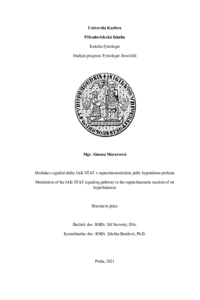Modulace signální dráhy JAK/STAT v suprachiasmatickém jádře hypotalamu potkana
Modulation of the JAK/STAT signaling pathway in the suprachiasmatic nucleus of rat hypothalamus
dizertační práce (OBHÁJENO)

Zobrazit/
Trvalý odkaz
http://hdl.handle.net/20.500.11956/148728Identifikátory
SIS: 144110
Kolekce
- Kvalifikační práce [19109]
Autor
Vedoucí práce
Konzultant práce
Bendová, Zdeňka
Oponent práce
Krulová, Magdaléna
Polidarová, Lenka
Fakulta / součást
Přírodovědecká fakulta
Obor
Fyziologie živočichů
Katedra / ústav / klinika
Katedra fyziologie
Datum obhajoby
13. 9. 2021
Nakladatel
Univerzita Karlova, Přírodovědecká fakultaJazyk
Čeština
Známka
Prospěl/a
Klíčová slova (česky)
JAK, STAT, suprachiasmatické jádro, cirkadiánní rytmusKlíčová slova (anglicky)
JAK, STAT, suprachiasmatic nucleus, circadian rhythmCirkadiánní hodiny v suprachiasmatických jádrech hypotalamu (SCN) regulují denní rytmy v chování a fyziologii a jsou důležitou součástí mechanismů regulujících homeostázu savců. SCN jsou synchronizovány s 24hodinovým cyklem především působením světla, ale mohou být regulovány také různorodými nesvětelnými signály, jako jsou růstové faktory, opioidy, cytokiny, nebo lipopolysacharid (LPS), které působí prostřednictvím aktivace signální dráhy JAK/STAT. Proteiny rodiny STAT (z angl. signal transducers and activator of transcription) regulují mnoho aspektů buněčné fyziologie od růstu a diferenciace až po imunitní odpověď. Signální dráha JAK/STAT však dosud nebyla v SCN zkoumána a funkce proteinů STAT v SCN není dosud objasněna. V první části práce jsme se zaměřili na lokalizaci proteinů STAT3 a STAT5 v SCN potkana a stanovení denního rytmu na úrovni proteinů i mRNA. Výsledky našich experimentů ukázaly denní rytmus v hladinách proteinu STAT3 v astrocytech SCN potkana s nízkou, ale signifikantní amplitudou a maximem v ranních hodinách. Dále byla odjevena silná, avšak ne rytmická, exprese proteinu STAT5A v astrocytech a proteinu STAT5B v neastrocytických buňkách SCN. Také bylo zjištěno, že Stat3 mRNA vykazuje podobně jako protein cirkadiánní rytmus v SCN potkana s vysokou úrovní exprese během dne a nízkou...
Circadian clock in the suprachiasmatic nucleus of the hypothalamus (SCN) regulates daily rhythms in behavior and physiology and is an important part of the mechanisms regulating mammalian homeostasis. SCN are synchronized with a 24hour cycle mainly by light, but they can also be regulated by a variety of nonphotic signals, such as growth factors, opioids, cytokines, or lipopolysaccharide (LPS), which act by inducing the JAK/STAT signaling pathway. STAT family proteins (i.e. signal transducers and activator of transcription) regulate many aspects of cellular physiology, from growth and differentiation to immune response. However, the JAK/STAT signaling pathway has not yet been studied in the SCN and the function of STAT proteins in the SCN has not yet been clarified. In the first part of the thesis, we focused on localization of STAT3 and STAT5 proteins in the rat SCN and determination of rhythm in proteins and mRNA. Our experiments showed the daily rhythm in the levels of STAT3 protein in SCN astrocytes of rat with low but significant amplitude and with maximum in the morning. In addition, we revealed strong but nonrhythmic expression of STAT5A protein in astrocytes and STAT5B protein in nonastrocytic cells of SCN. It was also found that Stat3 mRNA show, similarly to protein, circadian rhythm in...
